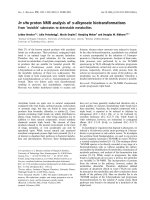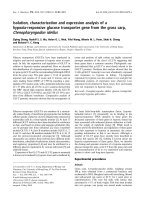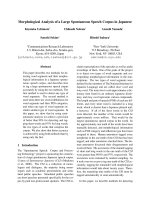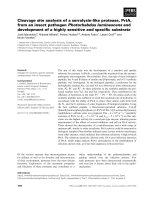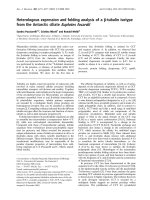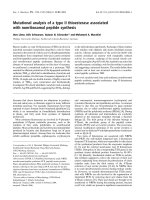Investment project analysis of a packaged fresh cake manufacturer
Bạn đang xem bản rút gọn của tài liệu. Xem và tải ngay bản đầy đủ của tài liệu tại đây (3.08 MB, 152 trang )
TRNG I HC M TP. HCM UNIVERSITÉ LIBRE DE BRUXELLES
HO CHI MINH CITY OPEN UNIVERSITY SOLVAY BRUSSELS SCHOOL
MBAVB4
NGUYEN NGOC HONG
INVESTMENT PROJECT ANALYSIS OF A PACKAGED
FRESH CAKE MANUFACTURER
MASTER PROJECT
MASTER IN BUSINESS ADMINISTRATION
(PART-TIME)
Tutor’s Name: Dr. NGUYEN MINH HA
Ho Chi Minh City
(2011)
i
ACKNOWLEDGMENT
I extent my thanks for all professors taking part in Vietnam Belgium master
program who are doing full of meaning jobs to open opportunities for me to approach a
new different education. Each lesson is a granted valuable gift which is always behind me
during my life and career path.
I would like especially thank to my tutor Mr. Nguyen Minh Ha for his help during
period of doing thesis. I am appreciate his devoted and meticulous comments on my
written paper from the commencement. There is no doubt that without his help, I would not
finish this paper.
I owe the debt of gratitude to my parents, brother and sister who always support me
by their own way and encourage me so much during the two year MBA course. They make
me feel a peaceful living to pursue my studying target for a better future.
Finally, I wish to thank my MBAVB4 friends who are willing to give the class their
supports which are derived from their kindness in a collective studying team. I am also
thank to friends in my studying group who have spend their time with me to debate issues,
search materials or patiently re-guide me lessons.
Without all these kindness of life, I would not be as I am today. Thank you.
ii
COMMITMENT
Hereby I, Nguyen Ngoc Hong, commit that this final thesis is my own work. No
part of this thesis has previously been submitted to any place by any means.
In consideration of confidential business opportunity, I confirm that this project is
for my final thesis only.
iv
EXECUTIVE SUMMARY
Since Vietnam joined the World Trade Organization (2007), the economy of
country has improved, which has led to rising disposable household incomes and
continuous improvements in living standards. Therefore, Vietnamese consumers are now
able to take better care of their health and well-being. In addition, the means of
communications feature health-oriented articles and programmers that are regularly
broadcast encouraging Vietnamese people to pay more attention to their health in order to
live happily as well improve life expectation. For these reasons, the health and wellness
trend continued to grow strongly in Vietnam throughout the review period, especially in
large cities such as Ho Chi Minh, Ha Noi and Da Nang.
On the social sight, the consuming expenditure has ever increased promptly as not
ever been before. The expenditure habit is gradually changed due to higher standard living
from higher income. It is also required products being suitable with life style which carry
out characteristics of convenience and easy for using. Food processing industry is not out
of modern tendency. Packaged food products are seem to become booming of demand.
Although it is a traditional market where famous brand name are existing, there is still
opportunities for new comers entering the market with its innovation and differentiation.
The changing in demand of food processing industry is on the sight of a group local
investors. The idea of implementation of project is executive in which catching the new
consuming trend by supplying top qualify, delicious and freshness packaged cakes that
satisfy convenience and healthy required from consumers. And, the project is being
considered to building a factory for production to exploit the local market. The idea is from
analyzing demand, supply, competitive and new consuming trend in term of market size,
growth and differentiation of products. It is discovered a new market segment to products
served for health and wellness of consumers. From the overall outlook, the production
capacity will be calculated for further investment consideration. When investing in long
term assets, many aspects are also considered such as location of the factory, life time
estimation or production machine system. And finally, financial figures are used to
measure the efficiency of the project. Risk analysis is carefully considered in the project
under impact of one and two variables senario as well as simulation analysis to find out
sensitive factors to the result for effective management. The aspect of operation and
v
production management is also mentioned as inventory, organization structure, human
resource, the cost of goods sold and working capital requirement. The final purpose of all
analysis is to rightly assessment the project and well management its performance after
investment decision.
By the end of analysis, the investor should be able to see the possibility and
profitability of this project that are used for further investment decision. For this project, it
has financial indicators as positive NPV and IRR greater than return on equity. It is
supported by others such as MIRR greater than return on equity, PI greater than 1, less than
the life of project to payback period of 5 years 8 months and discounted payback period of
8 years 2 months and ADSDR greater than 1. Based on these indicators, the project is
feasibility and the expected profitable return of investors is satisfied. Moreover, the
simulation analysis method figures 68.75% probability for NPV > 0. Therefore,the
investor should implement the project.
However, the investor should pay their attention on four sensitive factors as unit
price, productivity, raw material and sales cost for well management the performance. In
which, unit price is much more considered than others due to 72.3% contributed to
variance view. Moreover, during the project on operation, the investor should be caution on
controlling modern technology, spreading brand name and persuading distributors by sales
cost strategy. In conclusion, the next detail action plans after investment must be
considerate carefully to ensure a effective project.
vi
Table of contents
ACKNOWLEDGMENT i
COMMITMENT ii
TUTOR’S COMMENTS iii
EXECUTIVE SUMMARY iv
Table of contents vi
List of tables x
List of charts xii
List of pictures xiii
ACRONYMS xiv
CHAPTER I: INTRODUCTION 1
1.1 PROBLEM STATEMENT 1
1.2 OBJECTIVE OF THE STUDY 2
1.3 SCOPE OF STUDY 3
1.4 METHOD AND DATA OF STUDY 3
1.5 SIGNIFICANCE OF THIS STUDY 3
1.6 THE STUDY STRUCTURE 4
CHAPTER II: OVERVIEW OF INVESTORS AND THE PROJECT 5
2.1 THE OVERVIEW TO INVESTORS 5
2.2 THE OVERVIEW OF THE PROJECT 7
2.2.1 General information about the project 7
2.2.2 Introduction about products of the project 7
2.2.3 Introduction about the location of the project 9
CHAPTER III: THE MARKET ANALYSIS 11
3.1 OVERVIEW ABOUT INDUSTRY AND CAKE SEGMENT 11
3.1.1 General overview about macro-economics 11
3.1.2 The introduction about Packaged food industry 12
3.1.3 The introduction about Packaged Cake segment 15
3.2 DEMAND MARKET OF PACKAGED CAKE SEGMENT 15
3.2.1 The existing market size of Packaged Cake segment 15
3.2.2 The forecasting market size of Packaged Cake segment 17
vii
3.2.3 The demand characteristics of Packaged Cake segment 18
3.3 SUPPLY MARKET OF PACKAGED CAKE SEGMENT 19
3.3.1 Classification of competitive groups of the product 19
3.3.2 Classification of price to competitive products 22
3.3.3 The main players in existing market 23
3.3.4 The competitive landscape 26
3.4 ENTERING INTO THE MARKET GAP BY CATCHING CONSUMING
TREND AND DIFFERENTICATION 28
3.4.1 The consuming trend outlook 28
3.4.2 The product differentiation of project 30
3.4.3 The market opportunity to enter into new segment of product 31
3.4.4 The capacity of project 32
CHAPTER IV: THE INITIAL INVESTMENT AND TECHNICAL ANALYSIS 34
4.1 MAIN PRODUCTION MACHINE SYSTEM 34
4.1.1 Auto-Bake technology 34
4.1.2 Overview the production process 35
4.1.3 The operation mechanism of production machine system 35
4.1.4 Supplementary equipments for auto-bake main production system 38
4.1.5 Capacity of production machine system 40
4.1.6 Supporting instruments for production 41
4.2 BUILDING PRODUCTION FACTORY 41
4.2.1 Cost for land using right 41
4.2.2 Building the main factory 42
4.2.3 The costs related to construct main factory 43
4.3 ADMINISTRATIVE COSTS UNDER PROJECT CONSTRUCTION 44
4.4 DEPRECIATION PERIOD TO CATEGORIES OF INITIAL INVESTMENT 44
CHAPTER V: OPERATION AND PRODUCTION MANAGEMENT ANALYSIS 48
5.1 SALES AND MAKETING MANAGEMENT 48
5.1.1 Production capacity exploited 48
5.1.2 Inventory and consumption ratio 50
5.1.3 Forecast revenue, marketing and sales cost 52
viii
5.2 ORGANIZATION STRUCTURE 52
5.3 HUMAN RESOURCE AND ADMINISTRATIVE MANAGEMENT 53
5.4 COST OF GOODS SOLD 55
5.5 FINANCIAL STRUCTURE OF PROJECT 57
5.6 PRO-INCOME STATEMENT 58
5.7 WORKING CAPITAL REQUIREMENT 61
5.8 PRO-CASH FLOW STATEMENT 64
CHAPTER VI: PROJECT EVALUATION AND RISK ANALYSIS 66
6.1 THE EXPECTED RATE OF RETURN OF INVESTORS 66
6.1.1 Estimating the factors of CAPM base on characteristics of project 66
6.1.2 Estimating the Return on equity, R
e
69
6.2 FINANCIAL ANALYSIS ON EQUITY POINT OF VIEW 69
6.3 PROJECT VALUATION CRITERIA 70
6.3.1 Net present value - NPV method 70
6.3.2 Interest Rate of Return - IRR method 70
6.3.3 Modified Internal Rate of Return – MIRR method 71
6.3.4 Profitability Index – PI method 71
6.3.5 Regular Payback – RP method 71
6.3.6 Discounted Payback – DP method 71
6.3.7 The Annual Debt Service Capacity Ratio – ADSCR method 71
6.4 THE RESULT OF PROJECT VALUATION 72
6.5 RISK ANALYSIS 72
6.5.1 Sensitivity analysis under impacted one variable 72
6.5.2 Sensitivity analysis under impacted two variables 77
6.5.3 Scenario analysis 81
6.5.4 Simulation analysis 82
6.6 THE IMPACT OF A DEBT STRUCTURE 84
6.7 PROJECT VALUATION UNDER INFLATION ENVIROMENT 85
CHAPTER VII: CONCLUSION AND RECOMMENDATION 89
7.1 CONCLUSION 89
7.2 RECOMMENDATION 90
ix
REFERENCES 91
APPENDIX 1: AUTO-BAKE PROCESS AND TECHNOLOGY OVERVIEW 94
APPENDIX 2: BUILDING MATERIAL STANDARDS FOR FACTORY 106
APPENDIX 3: INTRODUCTION ABOUT BID TENDERS 109
APPENDIX 4: CALCULATION RATE OF RETURN (Re) BY CAPM METHOD
APPROACH 112
APPENDIX 5: FINANCIAL MODEL WITH REAL VALUE. 118
APPENDIX 6: FINANCIAL MODEL WITHOUT DEBT STRUCTURE 132
APPENDIX 7: FINANCIAL MODEL UNDER INFLATION 135
x
List of tables
Table 2.1: The investors of project and their chapter capital 6
Table 3.1: Compare between competitive products in the market 20
Table 4.1: The separate equipments assembled in machine system and its suppliers 37
Table 4.2: The list of main machines in a fully production line 40
Table 4.3: Oven Power Loading and Out Put Chart of production system 40
Table 4.4: The price for renting the land located the factory of project 42
Table 4.5: Price offering of 6 tenders for constructed categories 43
Table 4.6: The list of items of total initial investment capital 44
Table 4.7: The depreciation period applied on initial investment categories of project 45
Table 4.8: Depreciation schedule for initial the project of initial investments 46
Table 5.1: Production capacity planed to exploit year by year 49
Table 5.2: Products in volume produced and consumed year by year 51
Table 5.3: The detail of human resource cost 54
Table 5.4: The weighted and cost ratio between inputs and outputs 55
Table 5.5: Cost of goods sold of the project 56
Table 5.6: The detail of loan financed project 57
Table 5.7: Debt repayment schedule 58
Table 5.8: Financial structure of project 58
Table 5.9: Pro-income statement 60
Table 5.10: Turnover of working capital requirements 61
Table 5.11: Working capital requirement 63
Table 5.12: Pro-cash flow statement on equity point of view 65
Table 6.1: Calculate the beta of project by CAPM approach 68
Table 6.2: Calculate Return on equity (R
e
) by CAPM approach 69
Table 6.3: The result of project valuation 72
Table 6.4: Sensitivity of unit price on the NPV and IRR 73
Table 6.5: Sensitivity of productivity on the NPV and IRR 73
Table 6.6: Sensitivity of raw material cost per piece on the NPV and IRR 74
Table 6.7: Sensitivity of marketing cost on the NPV and IRR 75
Table 6.8: Sensitivity of sale cost on the NPV and IRR 75
xi
Table 6.9: Sensitivity of human resource expense on the NPV and IRR 76
Table 6.10: Sensitivity of unit price and raw material cost on NPV 78
Table 6.11: Sensitivity of unit price and Productivity on NPV 79
Table 6.12: Sensitivity of unit price and sales cost on NPV 80
Table 6.13: Scenario analysis in best, base and worst case 81
Table 6.14: The result of project with a no dept capital structure 85
Table 6.15: The pro-cash flow statement under inflation 87
Table 6.16: The result of project under inflation 88
xii
List of charts
Chart 3.1: Inflation rate year on year 12
Chart 3.2: Market size of Packaged Portion Bake in Volume 2005 - 2010 13
Chart 3.3: Market size of Packaged Portion Bake in Value 2005 – 2010 14
Chart 3.4: The scale of Packaged Cake on Packaged Portion Bake 15
Chart 3.5: Market size of Packaged Cake in Volume 2005 - 2010 16
Chart 3.6: Market size of Packaged Cake in Value 2005 - 2010 16
Chart 3.7: Forecast market size of Packaged Cake in Volume 2011 - 2015 17
Chart 3.8: Forecast market size of Packaged Cake in Value 2011 - 2015 18
Chart 3.9: The price of competitive products 23
Chart 5.1: Organization structure of the project 53
Chart 6.1: The NPV > 0 distribution by simulation run 83
Chart 6.2: The basis NPV distribution by simulation run 83
Chart 6.3: Sensitivity chart of variables 84
Chart 6.4: The inflation rate in Vietnam period July 2008 – July 2011 86
xiii
List of pictures
Picture 2.1: Long Hau Industrial Zone map location 10
Picture 4.1: Operation mechanism of production machine system 36
Picture 4.2: Paper Case Denesting unit equipment 38
Picture 4.3: Depositor unit equipment 39
Picture 4.4: Injection unit equipment 39
xiv
ACRONYMS
σ
(i)
: Standard deviation of Stock i
ρ
(iM
: Correlation between Stock i and the market return
σ
(M)
: Standard deviation of the return of market.
∆ : Change
ACB : Asia Commercial Bank
ADSCR : The Annual Debt Service Capacity Ratio
b
i
: Beta coefficient of Stock i
BMI : Business Monitor International Ltd
CAPM : Capital Asset Pricing Model
CF : Cash flow
Cf
o
: Initial cost
CF
t :
Expected future cash flow year t
COGS : Cost of Goods Sold
CPI : Consumer Price Index
DP : Discounted Payback
EBIT : Earnings Before Interest and Tax
ECF : Equity cash flow
Euromonitor : Euromonitor International Ltd
FIFO : First In First Out
G : Inflation rate
GDP : Gross Domestic Product
GMP : Good Manufacturing Practice
HACCP : Hazard analysis and critical control points
HCMC : Hochiminh City
IRR : Internal Rate of Return
ISO : International Organization for Standardization
MIRR : Modified Internal Rate of Return
NPV : Net Present Value
PBT : Profit Before Tax
xv
PI : Profitability Index
PV : Present value
Re : Return on Equity
Re : Expected return rate on equity (ROE)
Re
N
: Nominal discounted rate
Re
R
: Real discounted rate
RP : Regular Payback
RP
m
: Current market risk premium
r
RF
: Risk-free rate
SBV : State Bank of Vietnam
TNS : TNS Global Market Research Vietnam
TVC : Total Video Converter
USD : Unite State Dollar
VAT : Value added tax
VND : Vietnam Dong
WC : Working capital
w
i
: Weighted average of its individual stock i
1
CHAPTER I
INTRODUCTION
1.1 PROBLEM STATEMENT
The demand continues growing as the packaged products become popular to
Vietnamese consumers in term of consumption habits. It is to see more and more frequent
using habit in the school, the office, the tour, etc that rarely ever been before. This habit is
being to contribute to the industry growth. Besides, consuming awareness is also change.
The Vietnamese normally used packaging as an reference for justify product quality. The
habit changing is explained by survey of TNS Vietnam (2010) who found out five top
reasons rate for their favorite brands “59% by top quality, 39% by innovation, 38% by well
designed, easy to use, 34% affordable good value of the money and 27% great advertising
and marketing”. Therefore, a top quality of product is required, customers are attracted by
convenience products and be able to change their buying behavior by outward performance
or marketing image.
A market report stated that “a big trend in consumer awareness is growing for
health and wellness. As the economy continues to improve and people have higher
disposable income, they will be able to afford better products, and thus start to look at the
nutritional value of the products they purchase instead of just taste and price”
(Euromonitor, 2010). It is same with survey result of TNS Vietnam (2010) that 62% teens
care about being healthy and maintaining a positive outlook – securing their future and
74% eating healthy. Driven by rising incomes and the desirable better living standards, the
health and awareness trend in Vietnam is expected to move along with the global trend and
continues developing further in the future. At most consumers will have better education,
together continuous efforts from the government and manufacturers to raise the awareness
of people about health issues, they are expected to have better and more sophisticated
knowledge about health and wellness, and have higher demand for these products.
Although healthy products are still a niche area in Vietnam, rising consumer awareness for
this trend opens up new opportunities for the manufacturers. The tendency market is
demanded healthy fresh products.
Although existing competitors are densely and their capacities are always adapt to
2
existing market demand, there is still opportunity for new players entering the new
segment market. Market demand is changing which is higher required than previous. The
disadvantage of existing manufacturers is to switch innovate technology to adapt new
demand. The heavy investment on production capacity for existing products maybe lead to
be slower than new players in catching the new market demand. Therefore, one of the
competitive advantages of new players is modern technology producing modern products.
They also have new vision and clarify the new segment even it is the niche. Nowadays,
three ingrained product trends become be decisive factors for buying decision of customers
which are indulgence, convenience, healthy and safety (TNS Vietnam, 2010). As the
report, there are 89% said “I buy brands that are of good quality, even more expensive”,
“75% are prepare to pay more for products that make their life simpler” and 88% said “ I
am ready to pay a higher price for healthier foods”. It means that there is a market gap to a
new segment for packaged fresh and green products even been willing to pay more.
The increasing of urban household income is still recorded. The wealthy income
class (higher 13,500,000 VND/month) has increased by 33% in 2010 compare to 2009,
while the middle class in urban Vietnam has doubled in two years 2009 and 2010 (TNS
Vietnam, 2010). Moreover, the expenditure on food on a per capita basis in Vietnam is
expected to continue increasing over the next few years to reach increase more 80% in
2014 compare to 2009, reaching the volume USD 470 in 2014 compare to USD 262 in
2009 (Agriculture and Agri-Food Canada, 2011). Increasing income allows Vietnamese
consumers to diversify and improve their diets and spend more on food in general.
The products of project satisfy requirements about high standard living of people as
a naturally desire of increasing income. As Maslow's hierarchy of needs, the safety in
health is rising when people is satisfied the basic demand. The implementation of project
brings to consumers the products ensuring their health by freshness, satisfying their taste
by delicious and deserving their payment by top qualify.
1.2 OBJECTIVE OF THE STUDY
Due to the above attractive factors, this study endeavors to evaluate the feasibility
of a investment project of packaged fresh cake manufacturer in Vietnam based on market
analysis and financial indicators. The result of assessment is used to support investors in
3
making decision whether should invest on the project with their expected return.
The project is taken aim to calculate the production capacity that meet the target of
investors for a expected certain market share. Besides the financial aspect, followings are
technology, sales, cost of goods sold, direct and indirect labor forces and organization chart
put on the strategic to reach its mission.
1.3 SCOPE OF STUDY
The study is scoped in term of financial point of view. It is mainly focused on
preparation stage. However, it also includes forecasts after making investment decision
during the life of project as revenue, costs as the means to calculate of financial indicators.
Therefore, economics or social point of view are not mentioned on this scope of study.
1.4 METHOD AND DATA OF STUDY
The research will be implemented by in-depth interviews to managers and owners
of the project. In addition, a survey of market data is carried out to support for the market
analysis. Focus groups will be made to explore more ideas and insights of customers.
The price market of competitive products is collected by practical survey of own
author at places where products are displayed. The investment and production costs is
collected by suppliers by their price offers on reality market.
Information on macro economics is the main source of macro-economic, political,
country outlook from BMI Vietnam Business Report. General Department of Vietnam
Customs, Ministry of Finance and Vietnam Government portal provide sources about legal
documents, circulars, decrees and decisions.
Information of the industry is mainly from reports of Euromonitor and TNS Global
Market Research Vietnam surveys. Other information is based on realistic reports of
companies.
1.5 SIGNIFICANCE OF THIS STUDY
This study aims to give full of analyzed information about market and technology
to investors. Especially, financial information is analyzed leading to indicators supporting
to their making decisions. The following propose is to manage the performance of project
4
by analyzing impacted input and output variables in order to management resources at the
best effectiveness in changeable reality conditions.
1.6 THE STUDY STRUCTURE
The project is covered by seven chapters. Chapter one is introduction about overall
thesis as it objective, scope and method research. Chapter two is begun by introduction of
the project about investors and details of project. Chapter three is focused on the market
analysis to seize the supply and demand market, find out the main competitors and identify
the competitive landscape. From that, consuming trend is on vision that lead the project a
solution to enter into the market. Further studying is chapter four that goes to inside the
project by the initial investment and technology analysis. The other inside analysis is
operation and production management presented in chapter five. The chapter six reports
the result of project through project valuation and risk analysis. The final chapter seven is
conclusion and recommendation.
5
CHAPTER II
OVERVIEW OF INVESTORS AND THE PROJECT
2.1 THE OVERVIEW TO INVESTORS
The idea of implementation the project is taken shape from a group local investors.
They are business man who have been successful in two industries as real estate and
pharmaceutical in the form of limited liability and joint venture company. They currently
are managers and members of management board of companies have their own capital.
Before gathering to join in this project, they have being experienced in management as
well as leadership in many companies being effective performance. The curriculum vitae
records are persuaded that they have management and financial capacity, experience in
Vietnamese market, good social relationship and foresee new visions.
These local investors discovered a potential market to food processing industry
from their business experience to young, large and crowded market as Vietnam. Increasing
income and gradually changing in the style of life is on their sight. People become to
require products satisfying their modern life by convenience and healthy. Besides, they are
also realized that existing market players are on heavy investment on machine system for
existing products that are not less suitable to the required new demand. Under business
experience of investors and their keen in catching investment opportunities, the general
observation to the tendency of market leads to cooperation decision to invest on the
project.
The investors are on the consideration to implement the project. They proceed with
carefully analyzing issues related to the project. And, they also consider about cooperative
forms of whether only local investors or joint venture to take advantages of foreign partner
to exploit its technology in food processing industry.
With least experience of local investors in food industry, they decide to invite a
strategic foreign partner joining in the project at the beginning who owns a successful
brand name of products similar with strategy of local investors in its country. The share is
divided to scale 60% to local investors and 40% to foreign partner. The capital scale is
planned to ensure the management of project belong to local investors. It is certainly a joint
venture company is established under the Law on Foreign Investment in Vietnam. Under
6
the Law, the form of joint venture enterprise is legally stated in the investment license for
each project in accordance with regulations of the Vietnamese Government.
The capital chapter is VND 54 billion from the commencement. This is an
approximately amount 30% of total investment cost. The details did not calculated at that
time, however the added capital is considered during the implementation of investment
project.
Table 2.1: The investors of project and their chapter capital
No Joint Venture Parties Amount (VND mil) Scale (%)
1 Local investors 32,400 60
2 Foreign investors 21,600 40
Total chapter capital 54,000 100
Source: Calculated by author
After meetings for negotiation about strategy of company, it is defined the field of
company is to produce and trade food processing products made from flour materials
including bakes, cakes, breads, sugar and ice cream. It is being perceived that a totally new
comer in food processing industry at Vietnam desires to put their first steps into existing
fierce competitive market where being available some dominants with the famous brand
name and loyal customers. The motivation of establishment company is derived from
capacity of local investors and experience of foreigner partner. Behind a legal entity have
just born officially without any experience in the industry in prior, that is combination of
talent business man and a successful brand name at its located country. It is added the
inspiration of investors who become confident to put their steps into a new market segment
by differentiation of the products will be accepted by Vietnamese market.
It is also the foundation of enthusiasm and motivate spreading in all members in the
company who are being oriented to the target and focusing all resources on strategy in
order to input a totally fresh brand name in mind of customers and shape a certain
proportion on market share scale.
7
2.2 THE OVERVIEW OF THE PROJECT
2.2.1. General information about the project
From the orientation of investment, the foundation purpose of joint venture is to
carry on an investment plan producing freshly-baked, high-quality goodies for mainly
domestic market. Its mission is to supply high quality and nutritious product for the
evolution of the Vietnamese youth. It therefore commits to bring the highest value for
target consumers through products. The end product is homemade-style baked goods
which industrially packaged and mass production to supply to consumers fresh bakes
without preserve chemical ingredients. The ending products are fresh baked cupcakes that
are filling, nutritious and packaged to be easy to eat anywhere.
The project is the first business of company as soon as establishment. Therefore, its
role is decisive to continuous survival of performance to a joint venture company. Starting
from total unknown brand is really a big challenge putting pressure on company at the
commencement. So the implementation project is required total resources and well
preparation from the setting up period. It is applied new modern production machine
system to gather with suitable technology as well as human resources, brand creation,
strategic decisions or distribution system. However, the investors believe on the success of
new business from discovering new segment to be able to compete by the product
differentiation on existing market of a densely-populated developing country. The
company is a new player in a game but gets benefits from invisible assets from joint
venture relationship to the foreign partner as production technology, processing recipe,
business experience nin the same industry and especially owning a successful brand name
with similar products at its located country – a Asian one fairy homogeneous to Vietnam.
2.2.2 Introduction about products of the project
First of all, the idea for products of project derived from required demand of a
social being gradually higher income and a new trend in consuming in which convenience
and quality are in priority. Besides, the second reason is that a existing market gap at the
current foreseen where packaged cake products are not freshness and fresh cakes are not
packaged. The last reason for idea of products is that exists a similar segment become
popular in other countries while still be strange in Vietnam market.
8
Being heritage of value of brand and valuable advantages from joint venture
relationship is one of the determinants to shape products of the project. The successful
lesson from foreign joint venture partner to products and brands meeting a set of criteria
included market dominance, customer loyalty, longevity, goodwill and overall market
acceptance is exploited to shape products. They are oriented to produce similar one which
are baked goodies made from all-natural popped rice in the pack that are filling, nutritious
and easy to eat anywhere. There are three main product lines:
+ Whatta Tops Cupcake is a moist chocolate cupcake with a thick chocolate
topping with delicious cream filling. A pack of Whatta Tops contains roughly around ten
individually packed mini muffins. These muffins are covered with chocolate on top, with
some rainbow sprinkles, and are filled with different flavors such as Strawberry, Vanilla.
+ Stuffins Cupcake is a soft chocolate cupcake filled with luscious filling in three
different flavors – Chocolate Fudge (Twin-Choco), Milk Cream (Choco-Milk) and Mocha
Fudge (Choco-Mocha).
9
+ Cheese Cupcake is a delightful cheese-flavored cupcake that's rich in butter and
milk; Butter Milk Cake is a creamy, butter cupcake that's oozing with real goodness; Ube
Cake is a creamy, ube-flavored cupcake that's oozing with real goodness.
2.2.3 Introduction about the location of the project
To implement the project, the inventors intend to rent a land area located on Long
Hau Industrial Zone to build a production factory. Long Hau Industrial Zone is a place far
away 20 km away Ho Chi Minh City, 3 km from Sai Gon Container Port, 26 km from Tan
Son Nhat Airport and 3 km from Phu Mu Hung new resident area. It connects conveniently
to HCMC and neighboring region through heavy transportation system as North – South
main street line, Ben Luc – Long Thanh highway, Sai Gon – Trung Luong highway or
Long Hau – Tan Lap – Highway 50 street line. It has beautiful landscape and green
environment. It gets many advantages to be easy for getting profits from using various
production materials of Mekong Delta areas and quickly convenient transport to
neighboring regions.
Moreover, the location is easy for investors to approach technological, social
infrastructure and professional services in HCMC. Interior traffic system, inside the zone,
is relatively developed to connect Long An Province and HCMC. Investors locating in the
zone are committed by industrial zone authorizes for sufficiently stable production electric
and water source. Besides, this zone has the wastewater treatment system which can meet
the legal requirements set by State regulation. Telecommunication system is also
completed as well as other services to ensure continuous production.
The land location plays an important role on the one hand to exploit advantages of
infrastructure in and nearby HCMC. On the other hand, saving transportation timing and
cost to HCMC market is considered. It is also convenient to import input materials and
production machine. Long Hau Industrial Zone is a good choice.
10
Picture 2.1: Long Hau Industrial Zone map location
Source: Long Hau Industrial Zone



